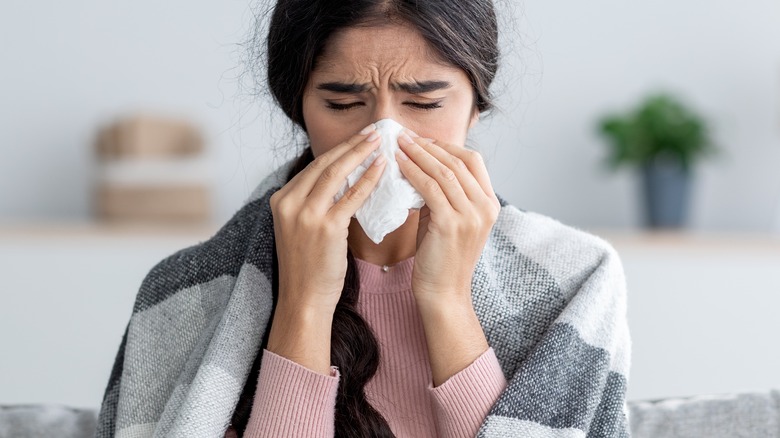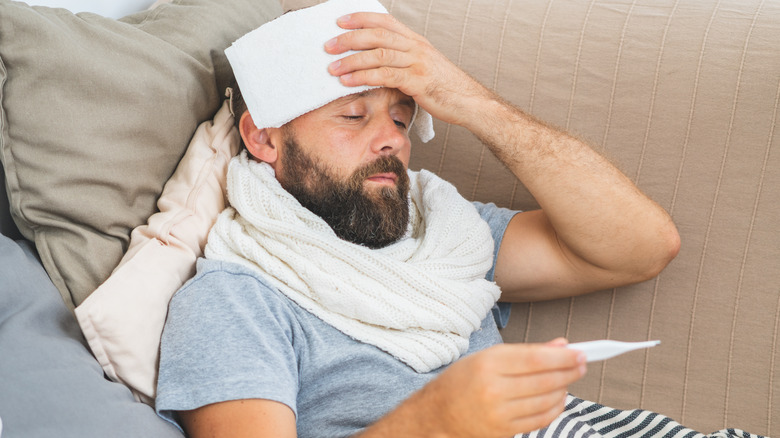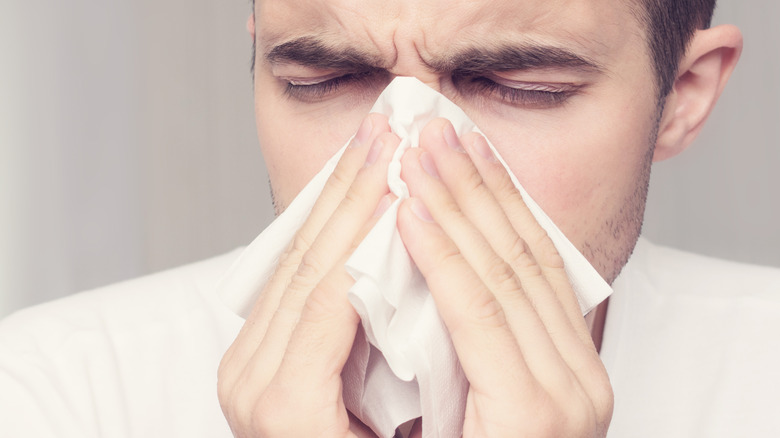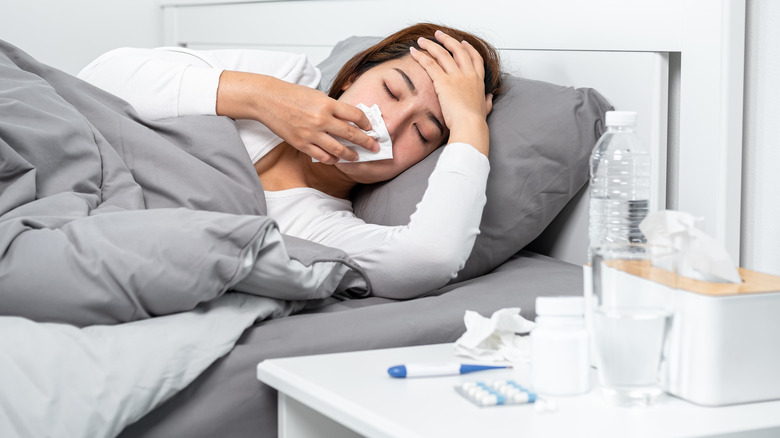7 Things To Do And 7 Things To Avoid When You Start Showing Flu-Like Symptoms
Having the flu can feel like you've been hit by a Mack truck. Your head and body ache, and you're so tired you can barely make it from the couch to the bed. You alternate between the chills and the sweats, and have a cough and runny nose that won't let up.
According to the Centers for Disease Control and Prevention (CDC), the flu is a highly contagious viral infection "caused by influenza viruses that infect the nose, throat, and lungs." Flu symptoms include fatigue, headache, muscle or body aches, fever or chills, runny nose, congestion, sore throat, cough, diarrhea, and vomiting (per the CDC). You can get the flu any time, but flu season is typical during the winter months, peaking midway from December to February (via the CDC).
The flu is more than just a bad cold. While most people will recover within a week or two, for some people, the flu can lead to moderate or severe health complications like sinus and ear infections, pneumonia, and even death. The CDC estimates that during the 2019-2020 flu season, there were 36 million cases resulting in 16 million doctor visits, 390,000 hospitalizations, and 25,000 deaths.
The flu virus is spread via droplets expelled by people while talking, sneezing, or coughing, or by touching a surface infected with the virus and then touching your eyes, nose, or mouth (per the CDC). If you start showing flu-like symptoms, here are some of the things you should do (and avoid doing).
Do: Stay home from work or school
Don't try to power through the symptoms. We know you don't want to be THAT person who stays home with " a little sniffle," but you also don't want to be the person who causes your entire office department to go down with the flu.
According to the CDC, the flu is most contagious during the first three days of infection. If you start to feel sick at work, go home, so you don't spread the virus. If you have a fever (a temperature of 100 degrees Fahrenheit/37.8 degrees Celsius or higher), stay home for at least 24 hours after your fever is gone, and refrain from using fever-reducing medication. If you don't have a fever, stay home for four to five days after the symptoms first manifest.
What if someone in your household has the flu? You can still go to work or school, but make sure to monitor yourself for symptoms. If you start to feel sick, go home.
Avoid: Strenuous exercise
We know exercise is essential for good health, but exercising when you have the flu is not a good idea. A study published in Nature Public Health Emergency Collection showed that exercising too hard can suppress the immune system and even exacerbate your symptoms.
According to the Mayo Clinic, you shouldn't exercise if you have "below the neck" symptoms (e.g. a congested chest, cough, or upset stomach), fever, aching muscles throughout your body, or fatigue. Otherwise, exercise is usually safe if you have "above the neck" symptoms (like a runny nose or a mild sore throat).
If you exercise when you're sick, listen to your body and use common sense. If you're getting over a cold but are typically in good health, some light exercise may help you feel better (via Harvard Health Publishing). Start with a short workout at a lower intensity and see how you feel. If you have the flu or another respiratory infection, wait until the fever is gone. Again, start with a short, low-intensity workout to gauge your condition.
Do: Treat flu-like symptoms
Do not ignore flu-like symptoms, especially if you're in a high-risk group. According to the CDC, high-risk individuals include anyone who is over 65 years of age, living in a long-term care facility or with a chronic condition (like diabetes) or compromised immune system, or pregnant (or two weeks post-partum). Additionally, certain racial and ethnic groups such as American Indians, Alaskan Natives, and Latinos may have a higher rate of severe flu infection.
Left untreated, some symptoms can lead to complications like dehydration, sinus and ear infections, bronchitis, or pneumonia (via Healthline). They may even trigger multi-organ failure. Unfortunately, there is no cure for the flu virus, but you can alleviate some of its symptoms. Cold-like symptoms such as cough, congestion, or runny nose can be alleviated with over-the-counter cold medication. Headaches, body aches, and fever can be reduced using acetaminophen or ibuprofen (via the Mayo Clinic). If you see a doctor within 48 hours of your symptoms manifesting, you may be eligible for an antiviral medication that can reduce the symptoms and duration of the illness (per Healthline).
Avoid: Taking a cold shower or bath to reduce fever
According to the Cleveland Clinic, a fever is the body's way of fighting an infection. What constitutes a fever? For adults, it's a temperature of 100.4 degrees Fahrenheit or more. For children, it's 100.4 degrees Fahrenheit or more when measured rectally, 99.5 degrees Fahrenheit when measured through the mouth, and 99 degrees Fahrenheit when measured under the arm.
When you feel feverish and sweaty, taking a cool shower or bath may seem like a good idea, but doctors don't recommend it (via ABC Health & Wellbeing). It sounds counter-intuitive, but cool water increases the core body temperature. If you want to bathe, take a lukewarm shower or bath. If you're experiencing body aches, try taking a bath in water with Epsom salts and baking soda (via Healthline).
For a mild fever (101 Fahrenheit or under), staying well hydrated and getting lots of rest are highly recommended (via the Cleveland Clinic). You can also take acetaminophen or ibuprofen for higher temperatures to control your fever. If your temperature stays at 103 degrees Fahrenheit or above for more than two hours after treatment or the fever lasts more than two days, contact your doctor. You should also contact your doctor if the fever is accompanied by a stiff neck, confusion, dehydration, irritability, rashes, or seizures.
Do: Try home remedies to relieve symptoms
According to the Mayo Clinic, simple, tried and true home remedies are among the most effective treatments for the flu. Drinking lots of fluids and getting plenty of rest tops the list. Drinking water, juice, or warm liquids like tea, broth, or chicken soup can help keep you hydrated and help loosen up mucus and congestion. Sleeping may be challenging when you're sick, but getting lots of rest boosts your immune system and gives your body a chance to recover. Treat a sore throat with ice chips or a saltwater rinse. For a saltwater rinse, boil some water and let it cool down to room temperature. Dissolve a quarter-teaspoon or half-teaspoon of salt in an 8-ounce glass of water. Gargle for 10 to 30 seconds, then spit it out.
Reduce nasal inflammation and soothe your sinuses, throat, and lungs with a cool-mist vaporizer or humidifier. Adding moisture to the air will help you breathe easier by reducing nasal swelling. Be sure to replace the water every day, and follow the manufacter's cleaning and maintenance guidelines for your vaporizer or humidifier.
You can also try steam inhalation to alleviate your symptoms (via Healthline). Heat water (do not boil) and place in a large bowl. You can add a few drops of essential oil or vapor rub to the water. Hold your face far enough from the bowl so you don't scald your face, and breath in the warm, moist air.
Avoid: Mixing lots of over-the-counter (OTC) medications
When you're not feeling well, your first instinct might be to go to the drugstore and buy anything and everything in the cold remedy aisle that promises to relieve your symptoms and make you feel better fast. However, just because over-the-counter (OTC) medications don't require a prescription doesn't mean you can throw caution to the wind when using them. Taking too much of them can worsen your symptoms — and mixing too many medications can be especially dangerous.
For example, using a decongestant spray for more than three days can worsen your congestion when you stop using it (via WebMD). Additionally, mixing acetaminophen (Tylenol) with OTC cold remedies that treat multiple symptoms (like Dayquil or Nyquil) is a recipe for disaster. Most multi-symptom medications already contain acetaminophen to help treat fever and body aches. According to Harvard Health Publishing, taking too much acetaminophen (more than 4,000 milligrams daily) can result in liver toxicity or fatal liver damage.
Be sure to read the labels on all your medications. Some of these products treat three to four different symptoms. Only take the product if you have all the symptoms listed. Taking a drug that treats a symptom you don't have is unnecessary, and could even cause side effects.
Do: Eat and drink foods that hydrate and nourish your body
You may not have much of an appetite when you have the flu. A sore throat can make swallowing difficult, and foods don't taste the same. However, staying hydrated and nourished is essential to feel better and have a faster recovery.
According to the Cleveland Clinic, warm fluids are best for fighting the flu. They keep you hydrated, and can help soothe a sore throat and loosen up congestion. Comforting foods like broths and soups contain nutrients and antioxidants that keep the body nourished and ultimately help you feel better. Herbal teas are another soothing and effective option. Per a study in Current Therapeutic Research, echinacea tea was just as effective as Tamiflu in shortening the duration of the flu. Additionally, eating fruits and vegetables with lots of vitamin C, like citrus fruits and dark green leafy vegetables, may help reduce your flu symptoms (per the Cleveland Clinic). If your stomach can't handle eating raw fruits and vegetables, try ingesting them in juice form, or adding greens to your soup.
Spices like cayenne, ginger and turmeric have many health properties and are used in soups and teas to treat cold and flu symptoms. Cayenne can help relieve congestion and headaches (via the Cleveland Clinic), but go easy, as it may worsen your runny nose or trigger heartburn. Ginger can help fight respiratory viral infections (via Healthline). Lastly, turmeric contains curcumin, which is an antioxidant with anti-inflammatory properties (per Healthline).
Avoid: Alcohol, caffeine, sugar, dairy products, and spicy foods
According to the Cleveland Clinic, sick people should avoid foods that are dehydrating or hard to digest, weaken the immune system, and worsen symptoms.
For instance, while a hot toddy may sound like a good idea, you should actually avoid alcohol when you're sick. Not only is alcohol dehydrating, but it also negatively affects your immune system's strength. Also, mixing alcohol with acetaminophen or other OTC medications could damage the liver (per Harvard Health Publishing).
Avoid caffeinated and sugary drinks like coffee, tea, and soda. Caffeine is both dehydrating and stimulating, which can make it challenging to get the rest you need. Instead, drink decaffeinated coffee or caffeine-free herbal teas. Sugary sodas increase inflammation and have no nutritional value, so drink watered-down fruit juice instead. Dairy products like milk and cheese can aggravate congestion by increasing mucus production. Instead of eating ice cream to soothe a sore throat, have an ice pop.
Lastly, spicy foods can help clear out congestion in the nose, but may be too much when you're already trying to fight a runny nose. Stay away from spicy foods for the first few days until you get your symptoms under control.
Do: Blow your nose the right way
According to Dr. Henry Danko from the Department of Internal Medicine at Rush University Medical Center, there's a right and wrong way to blow your nose. Blowing your nose too hard can cause mucus to go into the sinuses and eustachian tubes, increasing your chances of a sinus or ear infection.
To blow your nose correctly, gently blow one nostril at a time. This avoids reverse pressure, which can send mucus back into the sinuses and ears. Another option is to take a tissue and squeeze your nose dry. You avoid contaminating the sinuses and ears by pulling the mucus out of your nose.
To reduce the chances of spreading the virus, cover your mouth and nose when coughing or sneezing, but not with your hand. To avoid spreading the virus from your hands to a surface or another person's hands, the Mayo Clinic suggests coughing into a tissue, your arm, or your inner elbow. Last but not the least, wash your hands often.
Avoid: Lying flat on your back when resting
Getting lots of rest is essential when you have the flu, but let's face it: Trying to sleep when coughing and congested is not easy. And while lying flat on your back may seem like the most comfortable option in such situations, this position can actually cause mucus to pool in your throat, potentially making you cough and restricting your breathing (per Local 3 News).
To reduce postnasal drip and make breathing easier, use an extra pillow to prop your head up on an incline (via Healthline). Make sure not to use too many pillows, though, as this may make sleeping even more of a challenge due to the resulting neck discomfort.
Another way to improve your sleep quality is to keep your curtains drawn, so that the room is nice and dark (via the American College of Healthcare Sciences). If there are other people at home, it may help you to ask them to keep things a bit more quiet. You can also layer several blankets on the bed, so that you can stay warm and adjust as needed.
Do: Get tested for flu and COVID-19
According to the Mayo Clinic, the flu and COVID-19 share many of the same symptoms, including fever, chills and sweats, headache, shortness of breath and difficulty breathing, cough, fatigue, nasal congestion, sore throat, vomiting, and diarrhea. In addition to these symptoms, COVID-19 can cause "a loss of taste or smell, pinkeye, nausea, and chest pain."
If you are experiencing any flu-like symptoms, it may be a good idea to get tested for both the flu and COVID-19. Even though the COVID-19 and influenza viruses present with similar symptoms, they each require different treatments. And although it's rare, it's possible to have the flu and COVID simultaneously.
Getting tested, particularly if you are in a high-risk group, is essential to get the proper treatment as soon as possible (via the Centers for Disease Control and Prevention). While most people can treat themselves at home, your doctor may prescribe an antiviral to reduce the symptoms and duration of one or both viruses (per the Mayo Clinic).
Avoid: Rushing to the ER
When is it time to go to the emergency room or see a doctor? Healthline says that typical flu-like symptoms such as fever, cough, runny nose, sore throat, or muscle aches don't exactly necessitate a trip to the emergency room. These symptoms can often be treated at home with rest, fluids, and OTC medications.
However, if you are a high-risk individual, you should see your doctor as soon as possible. The doctor may prescribe an antiviral to lessen the severity of the symptoms and avoid the risk of complications like bronchitis or pneumonia. You may also want to see your doctor if you don't get better within two weeks, if your symptoms worsen, or if you start to feel better and then get sick again. This could indicate that you have flu complications such as a sinus infection, bronchitis, or pneumonia.
Lastly, if you have any of the following symptoms, go to the emergency room: breathing difficulties, chest pains, confusion, severe vomiting or stiff neck, or sudden dizziness. If you experience losing consciousness while sick, this is also a sign you should see a medical professional ASAP.
Do: Ask your doctor if an antiviral is an option for you
According to Healthline, you may be eligible for an antiviral drug if you are in a high-risk group and have flu symptoms. While antiviral drugs don't cure the flu, they can help reduce the severity of the symptoms, as well as the duration of the illness (per WebMD). Such drugs work best when taken within two days of the first symptom manifesting, so call your doctor as soon as you have any flu-like symptoms.
Your doctor may prescribe one of these CDC-recommended, FDA-approved antiviral drugs: Tamaflu (or the generic version, oseltamivir phosphate); Relenza (zanamivir); Rapivab (peramivir), and Xofluza (baloxavir marboxil). Depending on which type of drug the doctor prescribes to you, it can be administered orally via a pill or liquid, inhaler, or intravenously by a healthcare provider. The length of treatment can be anywhere from one to five days.
Avoid: Asking your doctor to prescribe antibiotics to treat flu symptoms
According to the CDC, antibiotics are safe and effective drugs used to kill or stop the growth of harmful bacteria. They treat bacterial infections like strep throat, whooping cough, urinary tract infection, chlamydia, and life-threatening infections like E.coli, staph, and sepsis (via Aetna).
However, antibiotics work on bacteria, not viruses. They won't help relieve symptoms or shorten the duration of a cold or flu. With that said, you may be prescribed an antibiotic when you have the flu if you develop a secondary bacterial infection like an ear or sinus infection or bacterial pneumonia (via Healthline).
While antibiotics are generally safe, they have side effects such as diarrhea, rash, nausea, yeast infections, and allergic reactions (via the CDC). Taking them improperly or unnecessarily can lead to antibiotic resistance. According to Healthline, antibiotic resistance is when bacteria adapt to antibiotics due to repeated exposure, subsequently making normally potent medication less effective (and infections even harder to deal with).















